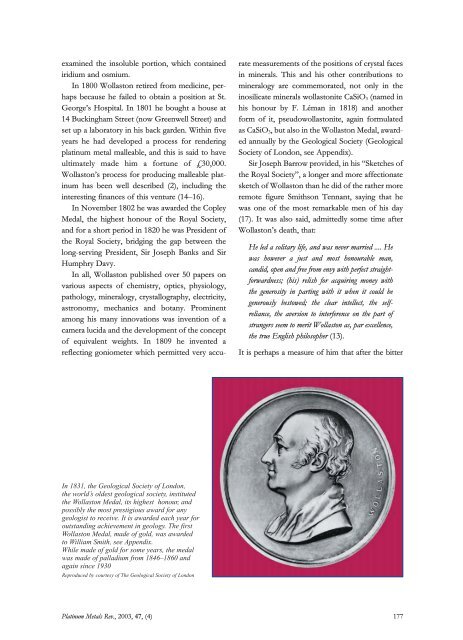Bicentenary of Four Platinum Group Metals - Platinum Metals Review
Bicentenary of Four Platinum Group Metals - Platinum Metals Review
Bicentenary of Four Platinum Group Metals - Platinum Metals Review
Create successful ePaper yourself
Turn your PDF publications into a flip-book with our unique Google optimized e-Paper software.
examined the insoluble portion, which contained<br />
iridium and osmium.<br />
In 1800 Wollaston retired from medicine, perhaps<br />
because he failed to obtain a position at St.<br />
George’s Hospital. In 1801 he bought a house at<br />
14 Buckingham Street (now Greenwell Street) and<br />
set up a laboratory in his back garden. Within five<br />
years he had developed a process for rendering<br />
platinum metal malleable, and this is said to have<br />
ultimately made him a fortune <strong>of</strong> £30,000.<br />
Wollaston’s process for producing malleable platinum<br />
has been well described (2), including the<br />
interesting finances <strong>of</strong> this venture (14–16).<br />
In November 1802 he was awarded the Copley<br />
Medal, the highest honour <strong>of</strong> the Royal Society,<br />
and for a short period in 1820 he was President <strong>of</strong><br />
the Royal Society, bridging the gap between the<br />
long-serving President, Sir Joseph Banks and Sir<br />
Humphry Davy.<br />
In all, Wollaston published over 50 papers on<br />
various aspects <strong>of</strong> chemistry, optics, physiology,<br />
pathology, mineralogy, crystallography, electricity,<br />
astronomy, mechanics and botany. Prominent<br />
among his many innovations was invention <strong>of</strong> a<br />
camera lucida and the development <strong>of</strong> the concept<br />
<strong>of</strong> equivalent weights. In 1809 he invented a<br />
reflecting goniometer which permitted very accurate<br />
measurements <strong>of</strong> the positions <strong>of</strong> crystal faces<br />
in minerals. This and his other contributions to<br />
mineralogy are commemorated, not only in the<br />
inosilicate minerals wollastonite CaSiO 3 (named in<br />
his honour by F. Léman in 1818) and another<br />
form <strong>of</strong> it, pseudowollastonite, again formulated<br />
as CaSiO 3, but also in the Wollaston Medal, awarded<br />
annually by the Geological Society (Geological<br />
Society <strong>of</strong> London, see Appendix).<br />
Sir Joseph Barrow provided, in his “Sketches <strong>of</strong><br />
the Royal Society”, a longer and more affectionate<br />
sketch <strong>of</strong> Wollaston than he did <strong>of</strong> the rather more<br />
remote figure Smithson Tennant, saying that he<br />
was one <strong>of</strong> the most remarkable men <strong>of</strong> his day<br />
(17). It was also said, admittedly some time after<br />
Wollaston’s death, that:<br />
He led a solitary life, and was never married .... He<br />
was however a just and most honourable man,<br />
candid, open and free from envy with perfect straightforwardness;<br />
(his) relish for acquiring money with<br />
the generosity in parting with it when it could be<br />
generously bestowed; the clear intellect, the selfreliance,<br />
the aversion to interference on the part <strong>of</strong><br />
strangers seem to merit Wollaston as, par excellence,<br />
the true English philosopher (13).<br />
It is perhaps a measure <strong>of</strong> him that after the bitter<br />
In 1831, the Geological Society <strong>of</strong> London,<br />
the world’s oldest geological society, instituted<br />
the Wollaston Medal, its highest honour, and<br />
possibly the most prestigious award for any<br />
geologist to receive. It is awarded each year for<br />
outstanding achievement in geology. The first<br />
Wollaston Medal, made <strong>of</strong> gold, was awarded<br />
to William Smith, see Appendix.<br />
While made <strong>of</strong> gold for some years, the medal<br />
was made <strong>of</strong> palladium from 1846–1860 and<br />
again since 1930<br />
Reproduced by courtesy <strong>of</strong> The Geological Society <strong>of</strong> London<br />
<strong>Platinum</strong> <strong>Metals</strong> Rev., 2003, 47, (4) 177
















